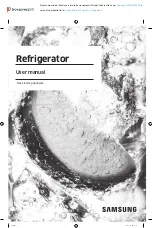
4-11
CAUTION
Take necessary steps (place plywood over coil or
use sling on motor) to prevent motor from falling
into condenser coil.
c. Remove motor mounting hardware and replace the
motor. It is recommended that new locknuts be used when
replacing motor. Connect wiring per wiring diagram.
d. Install fan loosely on motor shaft (hub side in). Install
venturi. Apply “Loctite H” to fan set screws. Adjust fan
within venturi so that the outer edge of the fan projects
(7.9 mm = 5/16”) out from edge of venturi. Spin fan by
hand to check clearance.
e. Close and secure condenser fan screen guard.
f. Apply power to unit and check fan rotation. If fan
motor rotates backwards, reverse wires 5 and 8.
4.18 RECORDING THERMOMETER (PARTLOW)
CAUTION
The inside mechanism of the control,
particularly the inside of the element housing
should never be oiled, however, control
mechanisms should be sprayed periodically
(every 60 days) with corrosion inhibiting CRC
3-36a or 6-66 or LPS no. 2.
3
4
1
2
5
1. Wind-up Key
2. Stylus
3. Set Screw
4. Pinion Shaft
5. Stylus Lifter
Figure 4-16. Partlow Recording Thermometer
a. Instruments for Checking Bulb Temperature
The recording thermometer may be equipped with
one or two Simpson accessories (#344 units), each
consisting of a thermistor probe and receptacle
(mounted to instrument case.) Single probe is attached
to the element (bulb) capillary which senses the container
return air temperature. If using two probes, the other
probe is attached to the supply air temperature sensor.
In the event of a failure with the #344 test lead, other
instruments for checking bulb temperatures are:
Simpson Meter, CTC P/N 07-00013 or Robinair Thermistor
Temperature Tester, Model 12860:
A resistance thermometer with RCA lead and a
phono-plug at each end may be used to compare bulb
temperature and stylus indicated temperature on chart by
inserting one end of the lead into receptacle provided on
the controller and other end in the meter. Always check
resistance thermometer before using. (Refer to para. b.)
Ohmmeter:
1. Place one probe of ohmmeter in the middle of
the receptacle provided on the chart platen, Figure 4-16,
and ground other probe to unit.
2. Note reading of meter and using Table 4-3,
convert resistance to temperature.
b. Checking Resistance Thermometer
Calibrate the resistance thermometer by completely
filling a thermos container full of ice cubes or chips and
filling the voids between the ice with plain water. Stir the
solution until the mixture registers 0 to 0.3
_
C (32 to
32.5
_
F), as indicated by a laboratory thermometer.
Immerse the resistance thermometer in the 0
_
C (32
_
F)
solution and check its accuracy at this temperature. With
this instrument, be certain that the recommended length
of the check probe is immersed so that it accurately will
reflect temperature. Bear in mind that this measurement
checks the test probe at 0
_
C (32
_
F) only; it is possible for
this type of instrument to be inaccurate at other
temperatures. Rezero check thermometer, if necessary,
by manufacturer’s instructions.
c. Checking the Recording Thermometer Bulb
Temperature
Checking
temperature
is
accomplished
by
comparing the instrument’s indicated temperature
(stylus) with the known temperature existing at the
element sensing bulb. To properly check the temperature
of the recorder, the element sensing bulb should be
stabilized at a temperature of 0
_
C (32
_
F). This is
accomplished by using one of the two following methods,
whichever is more convenient.
Unit Running:
Place set point at 0
_
C (32
_
F). After unit has pulled
down to this temperature, allow the compressor to cycle
ON-OFF 3 to 5 times to be certain temperature has
stabilized at 0
_
C (32
_
F) as verified by the resistance
thermometer. If the temperature indicated by the
thermometer differs from 0
_
C (32
_
F) by more than
0.6
_
C (1
_
F) when compressor cycles off, rezeroing must
be performed.
Unit Off:
Place the recording thermometer element (sensing
bulb) in 0
_
C (32
_
F) ice-water bath. Ice-water bath is
Downloaded from
















































